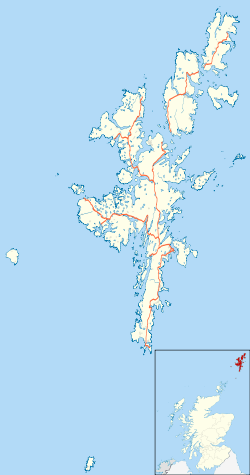Scalloway
| Scalloway | |
|---|---|
 Scalloway harbour, castle and town | |
 Scalloway Scalloway shown within Shetland | |
| Population | 1,000 (approx.) |
| OS grid reference | HU399393 |
| Civil parish | |
| Council area | |
| Lieutenancy area | |
| Country | Scotland |
| Sovereign state | United Kingdom |
| Post town | SHETLAND |
| Postcode district | ZE1, ZE2 |
| Dialling code | 01595 |
| Police | Scottish |
| Fire | Scottish |
| Ambulance | Scottish |
| EU Parliament | Scotland |
| UK Parliament | |
| Scottish Parliament | |
Scalloway (Old Norse:Skálavágr – "bay with the large house(s)") is the largest settlement on the North Atlantic coast of Mainland, the largest island of the Shetland Islands, Scotland. The village had a population of approximately 812, at the 2001 census. Until 1708 it was the capital of the Shetland Islands (now Lerwick, on the east coast of the Shetland Mainland).
Scalloway is the location of the North Atlantic Fisheries College (part of the University of the Highlands and Islands), which offers courses and supports research programmes in fisheries sciences, aquaculture, marine engineering and coastal management. It is also home to the Centre for Nordic Studies. Nearby are the Scalloway Islands, which derive their name from the town.
The village has a swimming pool and a school, Scalloway Junior High School, the secondary department of which was closed in July 2011 by the Shetland Islands Council.
History
Scalloway Castle was built in 1600 by Patrick Stewart, 2nd Earl of Orkney. The remains of the castle are the most notable feature of the village, located near the quay. (The castle is usually locked, but a key can be borrowed from the nearby Scalloway Hotel or from the adjacent Scalloway Museum.)
Norwegian boatbuilders from Hordaland, around the Bergen areas of Os and Tysnes, built yoals from about the 16th century. Oselvar, the traditional small wooden boat of Os, were taken apart and then 'flat packed' for shipping to Scalloway. Instead of sending complicated assembly instructions, they sent boatbuilders to rebuild them. Many of these stayed for years in Shetland, and some married there.
To the Hanseatic merchants from Bremen and Hamburg, Scalloway was known as Schaldewage, and as a good sheltered harbour on the route to Hillswick.
Barbara Tulloch[1] and her daughter Ellen – the last witches to be burned in Shetland – were executed on Gallow Hill, overlooking the village.
During World War II, Scalloway was the home base for, and housed for some time the headquarters of The Shetland Bus, part of the Norwegian resistance against the occupation of Norway by Nazi Germany. The Norway House and the Prince Olav Pier / slipway, which formed major parts of the base are still existing. Details of the history of The Shetland Bus are on display at the Scalloway Museum.[2]
In 1996, Kåre Emil Iversen published his wartime memoirs,I Shetland Bus Man. It was reprinted in 2004, with a new introduction and the title Shetland Bus Man. Another Shetland author Willie Smith discusses this period extensively in his 2003 memoir Willie's War and Other Stories as does David J. Howarth in The Shetland Bus published in 1998.
Other notable Scalloway authors include the prolific James R. Nicolson and the photographer/writer C.J. (Clement) Williamson.
After the war Scalloway served as harbour of the Shetland-Orkney ferry service (MV Orcadia) on the Scalloway–Stromness route. After the opening of the Schiehallion Oil Field off the west coast of Shetland, Scalloway took over some functions as a service base for the oil business.
Primary source
This article incorporates text from the article Scalloway on Shetlopedia, which was licensed under the GNU Free Documentation Licence until September 14, 2007.
References
- ↑ "SCT-SHETLAND-L Archives". Rootsweb. Archived from the original on 1 July 2012. Retrieved 2 January 2015.
- ↑ "Scalloway Museum". Culture24. Retrieved 16 December 2009.
Other sources
- Howarth, David (1950) The Shetland Bus: A WWII Epic of Escape, Survival, and Adventure (Lyons Press) ISBN 978-1-59921-321-7
- Iversen, Kaare (2000) Shetland Bus Man (Pentland Press Ltd) ISBN 978-1-85821-816-8
- Sorvaag, Trygve (2005) Shetland Bus: Faces and Places 60 Years on (Shetland Times Ltd) ISBN 978-1-898852-88-9
- Smith, Willie (2003) Willie's War and Other Stories (Shetland Times Ltd) ISBN 978-1-898852-97-1
External links
| Wikimedia Commons has media related to Scalloway. |
| Wikivoyage has a travel guide for Scalloway. |